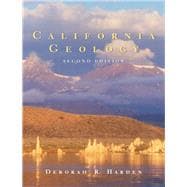
Note: Supplemental materials are not guaranteed with Rental or Used book purchases.
Purchase Benefits
What is included with this book?
Deborah R. Harden is a Professor in the Department of Geology at San Jose State University, where she teaches undergraduate and graduate courses in California geology and Earth-surface processes. Her particular interests are in landscape-forming processes, rivers, the effects of faults on streams, human impacts on watersheds, and California geology.
Before coming to San Jose State University, Dr. Harden worked as a geologist for a private engineering consulting firm and as a hydrologist for the U.S. Geological Survey. She has a Ph.D. from the University of Colorado and B.S. and M.S. degrees from Stanford University, all in geology.
Dr. Harden has had the privilege and opportunity of visiting and studying geology and landscapes in many parts of the world, both professionally and with her family.
| Basic Principles of Geology | |
| Plate Tectonics and California | |
| California's Rocks and Minerals | |
| Geologic Time, Dating Earth Materials, and California Fossils—Basics of Faults and Folds | |
| Geologic Maps and Sources of Information Including Web Sites | |
| Geological Highlights of California | |
| Young Volcanoes: The Cascades, the Modoc Plateau, and the Long Valley Caldera | |
| California's Deserts: Climate, Changing Environments, and Resources | |
| The Basin and Range and Mojave Desert: Old Rocks and Young Faults | |
| The Sierra Nevada: Granite, Gold, and Glaciers | |
| The Klamath Mountains: Accreted Terranes and a View of the Mantle | |
| Water in California | |
| The Great Valley: Sediments and Soils | |
| The Coast Ranges: Mountains of Complexity | |
| Earthquakes, Faults, and Seismic Safety | |
| The San Andreas Fault System | |
| The California Coast | |
| The Transverse Ranges, The Los Angeles Basin, and the Offshore Islands: Compression and Rapid Change | |
| The Peninsular Ranges | |
| California Geology: An Integrated View | |
| The Evolution of California Through Geologic Time | |
| Geology and California Citizens—Including Resources, Hazardous Geologic Processes, Climate Change, Changing Calif | |
| Landscape | |
| Glossary | |
| Place Index | |
| Subject Index | |
| Plates: Inside Front and Back Covers | |
| Geologic Map of California | |
| Fault Map of California | |
| Digital Shaded Relief Map of California | |
| Map Showing Major Mountain Ranges, Streams, Lakes, Highways, and Cities of California | |
| Table of Contents provided by Publisher. All Rights Reserved. |
The New copy of this book will include any supplemental materials advertised. Please check the title of the book to determine if it should include any access cards, study guides, lab manuals, CDs, etc.
The Used, Rental and eBook copies of this book are not guaranteed to include any supplemental materials. Typically, only the book itself is included. This is true even if the title states it includes any access cards, study guides, lab manuals, CDs, etc.